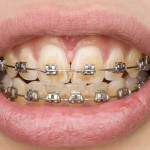
Orthodontists apply light forces to teeth in order to move them. Applying forces to teeth can be associated with pain which has been said to occur in 70-90% of patients. The intensity of this pain ranges from mild discomfort to throbbing pain. Studies have suggested that low-level laser therapy (LLLT) may reduce short -term orthodontic pain.
The aim of this review was to assess the effectiveness of near infrared low-level laser therapy in reducing orthodontic pain after the application of orthodontic force (OF).
Methods
Searches were conducted in the Medline, Embase, Scopus, Cochrane Library, Web of Science and EBSCOhost databases. Randomised clinical trials (RCT) analysing the effectiveness of LLLT in reducing orthodontic pain at 24 and 72 hrs after the application of OF and published in English were considered. Two reviewers independently selected studies abstracted data and assessed risk of bias using the Cochrane Tool. The GRADE approach was used to assess the overall body of evidence. The main outcome was pain assessed at 24 hrs and 72 hrs. Results were reported as continuous data using standard mean difference (SMD) and meta-analysis conducted using a random effects model.
Results
- 20 RCTs were included.
- 13 studies were considered to have a high risk of bias, 5 an unclear risk and 2 a low risk.
- The Visual Analogue Scale (VAS) used for pain assessment in 16 studies, 3 used the Numeric Rating Scale and one the Wong-Baker Faces Pain Rating Scale.
- Meta-analysis showed that in patients treated with laser versus placebo there was a difference in favour of LLLT in spontaneous pain 24 and 72 hrs after the installation of light archwires and spontaneous pain and chewing pain 24 and 72 hrs after the installation of elastomeric separators.
- After 24 hrs
- Spontaneous pain overall (6 studies) SMD= −1.11(95%CI; −1.69 to −0.53) ?2 = 38.6%).
- installation of elastomeric separators (4 studies) SMD= −0.76 (95%CI; −1.19 to −0.33) ?2 = 70%;
- installation of light archwires (2 studies) SMD= −2.09 (95%CI; −4.10 to −0.09) I2 = 89%);
- After 72 hrs
- Spontaneous pain overall (4 studies) SMD= −0.65(95%CI; −1.06 to −0.24) ?2 = 69%).
- installation of elastomeric separators (3 studies) SMD= −0.54 (95%CI; −0.91 to −0.17) ?2 = 58%)
- installation of light archwires (1 study) SMD= −1.54 (95% CI; −2.57 to −0.51).
- After 24 hrs
Conclusions
The authors concluded: –
LLLT proved to be effective in promoting a reduction in spontaneous and chewing pain after the application of OF; however, the poor quality of the evidence requires these results to be treated with caution.
Comments
Previously we have looked at two reviews from the Cochrane Collaboration on orthodontic pain. One considered pharmacological management (Dental Elf – 6h Dec 2017) and on non-pharmacological approaches (Dental Elf – 11th Jan 2017). LLLT was considered as part of the non-pharmacological review and they concluded;
there was low-quality evidence to suggest that LLLT may help control short-term orthodontic pain.
Only one of the trials included in the Cochrane review was included in this new review and 6 were specifically excluded. Cochrane are waiting to evaluate one of the studies included in this review leaving 12 studies included in this review but not in the Cochrane review. While 13 of the studies in this review reported pain reduction with LLLT and meta-analysis suggests a pain reduction the low quality of the available evidence and the differences between this review and the Cochrane Review suggest that the findings should be interpreted cautiously until evidence from well-reported high quality RCTs is available.
Links
Primary Paper
Deana NF, Zaror C, Sandoval P, Alves N. Effectiveness of Low-Level Laser Therapy in Reducing Orthodontic Pain: A Systematic Review and Meta-Analysis. Pain Res Manag. 2017;2017:8560652. doi: 10.1155/2017/8560652. Epub 2017 Sep 27. Review. PubMed PMID: 29089818; PubMed Central PMCID: PMC5635293.
Other references
Dental Elf – 6h Dec2017
Pain during orthodontic treatment –pharmacological treatments
Dental Elf – 11th Jan 2017
Pain during orthodontic treatment: non-pharmacological interventions
